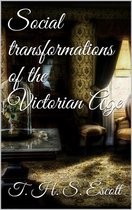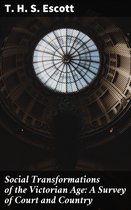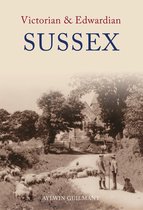Social Transformations of the Victorian Age: A Survey of Court and Country Ebook Tooltip Ebooks kunnen worden gelezen op uw computer en op daarvoor geschikte e-readers.
Afbeeldingen
Artikel vergelijken
- Engels
- E-book
- 9781465630940
- 24 februari 2021
- Adobe ePub
Samenvatting
As it is to-day, so, during the earlier years of the present reign, both before and after the Great Exhibition of 1851, Hyde Park was the social parade ground, not only of the capital, but of the Kingdom. Then, as now, its human panorama was the representative reflection of the social conditions not less than of the typical personages of the era. Throughout the later forties or the fifties, the loungers from the provinces were certainly not less numerous in Hyde Park than to-day. Foreign visitors were beginning to be a feature in the Metropolitan summer. But the scale on which the London season half a century ago was observed was so small as to resemble but faintly its successors known to the present generation. Society scarcely exceeded the dimensions of a family party. Hyde Park itself seemed a Royal pleasure ground first, a popular resort afterwards, to which strangers were, as to the Park at Windsor, admitted by favour of the first Constitutional Sovereign, to behold the pastimes of the rising generations of Royalty. The little boy and girl, steering their ponies through the maze of carriages, horses, or pedestrians, were the Prince of Wales and the Princess Royal. Observers noted with appreciative criticism the progress made from day to day by the young riders. Other of the Queen’s descendants of age still more tender, followed with their parents in an open carriage, the exact build of which had been introduced by the Prince Consort, and were manifestly being instructed by their father or mother in the art of acknowledging gracefully the respectful salutations of spectators. The company crowding the Park, and most familiar to London onlookers differed from the crowds of succeeding decades, first, in the monotony of its composition, secondly, in the commanding ascendancy of some among the individuals whom it numbered. This was a kind of feudal age in our social development. The monarch was surrounded by subjects, the splendour of whose station, or the lustre of whose endowments caused them to shine forth in their exalted firmament, with a light of their own not reflected by, though comparable with, that of Royalty itself. Two noblemen, during the first quarter of a century of the Queen’s reign, one Scotch, the other English, seemed to eclipse the rest of the peerage. The Earl of Eglinton, of the period now referred to, was famous, even among Englishmen, from the tournament held some years earlier in 1839 at Eglinton Castle, and described by Mr Disraeli in his last novel, Endymion. The lady who had been the Queen of Beauty upon the occasion, the Duchess of Somerset, was then a synonym for all which women envy or men admire. When she appeared in Hyde Park, the crowd gazed at her carriage with the awed admiration that they bestowed on those born to thrones. North of the Tweed, Lord Eglinton summed up to his adoring countrymen, in his own person, all the influence, the dignity, the splendour, the power, and all the other attributes of greatness with which the principle of birth could be endowed. What Lord Eglinton was in Scotland, or to the natives of Scotland in London, Lord Lansdowne had long been to all classes of Englishmen, not more in his native county than in London. Here, during the earlier Victorian seasons, he was conspicuous in Hyde Park, generally by his perfect demeanour of high breeding, specially by this blue coat and voluminous white neck investment. After him, slowly riding on a horse whose familiarity can best be expressed to readers of to-day by comparing it with that sometime attained by the white cob of Mr Lowe, Lord Sherbrooke, there appeared, in the blue coat and white trousers of the old régime, the figure before whom all heads instinctively uncovered, the great Duke of Wellington. On horseback, also, were two other men, second only in eminence to the Duke himself, Lord Palmerston, and Sir Robert Peel. The first still wore his years lightly and was as much at home in the saddle as in the House of Commons. Sir Robert Peel, still a remarkably handsome man, had the enthusiasm of the equestrian. Those who can recall the loose connection between Bishop Samuel Wilberforce and the steed which he bestrode, can form an idea of the ‘seat’ of the great Sir Robert.
Productspecificaties
Inhoud
- Taal
- en
- Bindwijze
- E-book
- Oorspronkelijke releasedatum
- 24 februari 2021
- Ebook Formaat
- Adobe ePub
Betrokkenen
- Hoofdauteur
- Thomas Hay Sweet Escott
- Hoofduitgeverij
- Library Of Alexandria
Lees mogelijkheden
- Lees dit ebook op
- Android (smartphone en tablet) | Kobo e-reader | Desktop (Mac en Windows) | iOS (smartphone en tablet) | Windows (smartphone en tablet)
Overige kenmerken
- Studieboek
- Nee
EAN
- EAN
- 9781465630940
Je vindt dit artikel in
- Categorieën
- Taal
- Engels
- Boek, ebook of luisterboek?
- Ebook
- Beschikbaar in Kobo Plus
- Beschikbaar in Kobo Plus
- Beschikbaarheid
- Leverbaar
Kies gewenste uitvoering
Prijsinformatie en bestellen
De prijs van dit product is 4 euro en 99 cent.- E-book is direct beschikbaar na aankoop
- E-books lezen is voordelig
- Dag en nacht klantenservice
- Veilig betalen
Rapporteer dit artikel
Je wilt melding doen van illegale inhoud over dit artikel:
- Ik wil melding doen als klant
- Ik wil melding doen als autoriteit of trusted flagger
- Ik wil melding doen als partner
- Ik wil melding doen als merkhouder
Geen klant, autoriteit, trusted flagger, merkhouder of partner? Gebruik dan onderstaande link om melding te doen.








